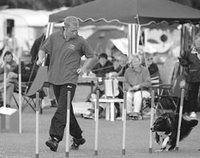We have, over a series of months, established a good nose touch to hand and nose touch to a plexiglass target. For both of these the target is the cue, my reasoning being that these are not end behaviours, but tools for teaching the end behaviour.
However, I am beginning to think that for many people the problem that their dogs have with contacts in a trial - as opposed to training - comes back to the cue for the behaviour. In a trial situation it may be that the problem is that the dog is waiting for what it thinks the cue is for the behaviour. And this might be quite different from what we think we have trained.
This was demonstrated rather well by Greg Derrett when he asked us all what our start line release cue was and for many (most?) dogs it was something quite different. So while we thought 'Go!' was the release, Rover thought that it was the word go said after mum stops looking at me, drops her arm and takes a running step.
It could be that correct performance on the contact is cued by a similar chain. Rover has learned his lesson well, "I stop with 2 feet on and 2 feet off when I can see that clear square thing , and mum sort of leans over the end of the board and points, and she has her other hand in the treat bag, and she says 'touch' in that smiley way she has when she is happy with me." If any of these elements are missing then it is not the cue for 2o2o.
The behaviour was not on stimulus control before it was transferred to the contact obstacle. We’re so pleased the dog is nose-touching the target, stopping 2o2o, dropping on a target, we move on to doing on the equipment long before the dog recognises the cue for the behaviour. What we need to establish is that Rover knows (and we know) the specific cue for the behaviour sufficiently well to perform it in a variety of circumstances.
With Dusty I'm working on a number of pre-contact obstacle skills. I haven't yet decided what her contact behaviour will be, I'll watch her and see if there is a natural behaviour that I can put on cue. With Thommo, the worrywart, I had to be careful not to do anything that he would interpret as a reproach so we didn't use a stop. I clicker trained him to run to the very end of any board, plank, steps, ramp, children's slide, skate pipe ... without jumping off. He has only ever missed a contact in one event.
I've been working this with Dusty too. We started with just a board flat on the floor, rewarding for going all the way to the end, and on a low wall in the park. Yesterday in the skate park she was doing great runs up quite a steep quarter pipe, and then running back down. I'd click as she got to the level area and drop a treat at her feet. After a few repeats she was running fast back to the end of the slope and stopping for her treat.
This morning I set up a hinged board across my ottoman, and encouraged Duz to jump up onto the ottoman. I then rewarded her for running down the sloping board to the end. At first I just clicked as she got to the end of the board, later I clicked when she paused at the end.
I hadn't done any work with a foot target with Dusty. But after working with her and the board I put a mouse pad on the floor for Thommo to earn some treats. On 'spot' he ran to the pad put one foot on and came back for his treat. Duz was just waiting, watching the treats (learning that even if treats are around she doesn't necessarily get one). Thommo touches the pad three times, three treats. Dusty then runs across, does a perfect one paw touch and comes back for her treat.
Entertained, I then called a name before saying 'spot' and tossed the treat in opposite directions for each dog, to give the other time to get to the target. When I thought the name had become part of the cue I made it harder, getting them to wait for their turn. A touch without a cue didn't get a reward. Dusty picked it up as quickly as Thommo.
Not sure how useful this will be, but it was fun.
 Greg supervises Jaycee Sproglett through the weaves.
Greg supervises Jaycee Sproglett through the weaves.